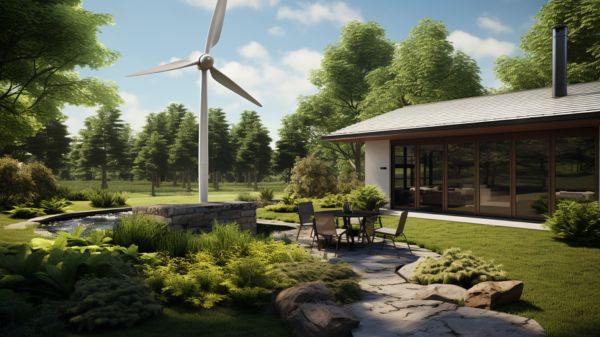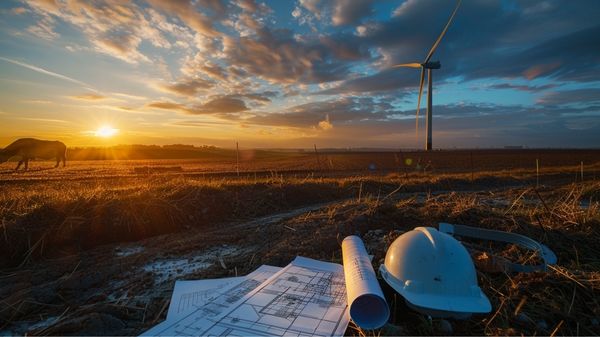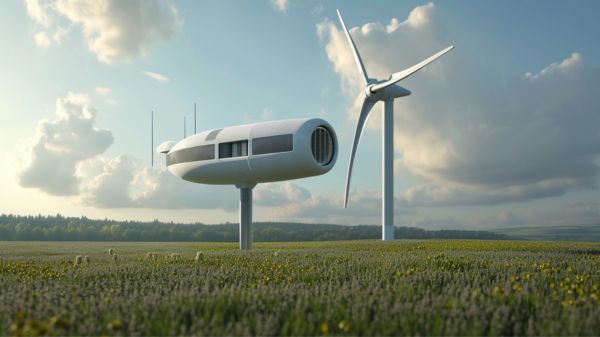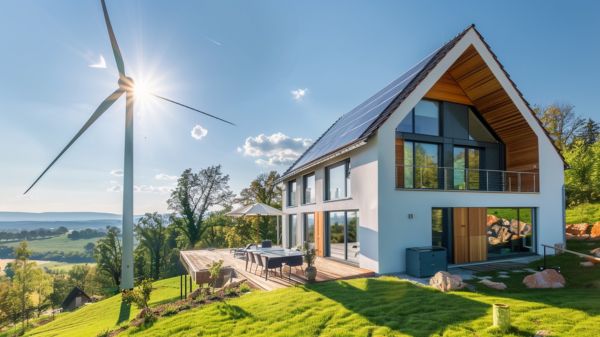In the domain of renewable energy, wind power stands out not only for its environmental benefits but also for its compelling cost advantages. Notably, the reduction in installation costs by nearly half since 2008, alongside markedly low operating expenses, underscores a trend towards fiscal prudence and long-term sustainability in energy production.
Furthermore, the role of federal incentives in bolstering this sector cannot be overstated, as they contribute substantially to both job creation and national economic output. However, while these factors suggest a robust case for wind energy, the complexities of market dynamics and technological integration present challenges that merit closer examination.
⚡OFF-GRID POWER⚡
Build a Home Power Backup—No Utility Needed
Looking to keep essentials running during outages? The Ultimate Off-Grid Generator course walks you through a DIY backup system with simple parts and step-by-step plans — ideal for homesteads, cabins, or emergency prep.
Key Takeaways
- Installation costs for land-based wind projects decreased by 40% since 2010, enhancing economic viability.
- Operation costs are low, around $40 per kW/year for land-based turbines.
- Federal tax incentives and the Inflation Reduction Act lower capital requirements and boost investment returns.
- Wind energy pricing is competitive, sometimes dropping to $20/MWh, cheaper than fossil fuels.
- Local communities benefit financially through tax payments, land leases, and job creation.
Decreased Installation Costs
As the wind power sector has evolved, a notable trend in decreased installation costs has emerged, making this renewable energy source more accessible and economically viable.
Land-based wind turbine prices have greatly dropped, decreasing by 50% from 2008 to 2020, with current prices ranging from $850 to $950 per kilowatt (kW). This reduction enhances the competitive pricing of wind energy in the energy generation market, particularly when compared to traditional energy sources.
Furthermore, the average installed cost of land-based wind projects has also seen a remarkable decline. In 2020, these costs were approximately $1,460 per kW, reflecting a reduction of over 40% since the 2010 peak.
Such cost efficiency in installation not only liberates developers from high initial capital expenditures, which typically range between $1,200 and $1,800 per kW, but also promotes broader adoption.
Offshore wind projects, while more costly—ranging from $3,500 to $4,000 per kW—still present an essential aspect of the renewable portfolio, despite higher initial outlays.
The levelized energy cost, reported at $39 per megawatt-hour (MWh) in 2022, underlines the economic advantage and viability of wind projects, confirming their role in a sustainable energy future.
Lower Operation Expenses
In the domain of wind power generation, a significant advantage is presented by lower operation expenses. The operation and maintenance costs of wind energy, particularly for land-based and offshore wind farms, underscore its economic viability and environmental appeal.
Unlike fossil fuel-based power plants, wind energy enjoys the benefit of minimal ongoing fuel costs, which fundamentally contributes to its low overall operating expenses. Here is a comparative overview of the operating costs:
| Type | Cost per kW/year | Cost per kWh |
|---|---|---|
| Land-based Wind | $40 | 8.66 cents |
| Offshore Wind | Varied | 22.15 cents (2013) |
| Fossil Fuels | Higher | Higher |
Advancements in technology not only promise to decrease these costs further but also enhance the reliability and efficiency of wind farms. This ongoing reduction in maintenance costs, especially with offshore wind, despite its historically higher expenses compared to land-based setups, highlights the forward strides in wind technology.
Such improvements make wind energy a progressively attractive option, steering the energy market away from more costly and environmentally damaging fossil fuels towards a more liberated and sustainable future.
Economic Incentives
The Biden Administration’s Inflation Reduction Act represents a pivotal shift towards green energy, earmarking substantial financial incentives specifically designed to enhance the profitability and expansion of wind power projects. By channeling billions into the sector, the Act strategically strengthens the economic foundations of renewable energy, encouraging investment and innovation in wind technology.
Additionally, the integration of advanced forecasting and control systems has further optimized the efficiency and reliability of wind power, aligning with grid demands and reducing variability issues.
Federal tax incentives are essential in maintaining competitive cost structures for wind energy, thereby reinforcing the sector’s appeal to investors. These incentives not only lower the initial capital required but also improve the return on investment over time, making wind projects more financially attractive.
As a result, the wind industry has seen significant growth, adding value to both the economy and the job market. In 2022 alone, wind energy contributed around $20 billion to the U.S. economy, highlighting its potent economic impact.
Moreover, the proliferation of wind projects has fostered job creation, with over 125,000 positions currently supported and projections suggesting hundreds of thousands more by 2050. These jobs span from construction to maintenance, driving economic activity across various states.
Additionally, local and state tax revenues from wind farms bolster public services, enhancing community benefits and supporting local economies. This extensive approach not only bolsters renewable energy but also secures socio-economic advantages.
Competitive Energy Pricing
Frequently, the competitive pricing of wind energy emerges as a compelling argument for its broader adoption in the energy market. Land-based wind energy, with a levelized cost of approximately $39/MWh as of 2022, underscores its cost-effectiveness compared to traditional energy sources. This pricing is particularly notable when compared to natural gas and coal, where wind energy pricing in the interior U.S. can dip as low as $20/MWh.
The sharp decrease in installed costs for land-based wind projects, ranging between $1,200 and $1,800 per kilowatt—a reduction of over 40% since 2010—further amplifies wind energy’s competitive edge. These cost efficiencies are propelled by technological advancements and economies of scale, coupled with significant federal tax incentives which have been pivotal in maintaining low wind energy costs. These incentives guarantee that wind remains a formidable competitor in the energy sector, constantly challenging the economic viability of more traditional energy sources.
Moreover, the affordability extends to small distributed wind systems, with levelized costs around $235/MWh for residential and $163/MWh for commercial applications, making wind energy a viable option across various market segments. This pricing strategy not only supports the economic case for wind energy but also empowers energy liberation, reflecting a shift towards more sustainable and economically feasible energy solutions.
The reliability of wind energy has been proven over time with increasing global wind energy production, indicating a consistent and dependable power supply.
Community Financial Benefits
Building on the competitive pricing of wind energy, its economic advantages extend beyond mere cost savings to encompass substantial financial benefits for local communities. Wind energy projects bring significant revenue into these areas through state and local tax payments. These funds are pivotal for supporting public services such as education and essential infrastructure improvements, thereby enhancing the quality of life for residents.
In addition, the presence of wind farms often results in lucrative land-lease agreements for farmers and ranchers. These agreements provide stable income streams that help to diversify and strengthen the financial stability of agricultural operations.
Additionally, distributed wind systems offer households and businesses the opportunity to reduce their retail energy purchases. Not only does this lower their energy bills, but it also allows them to earn credits for any surplus power generated, further offsetting costs and contributing to household savings.
Considering the global installations of wind power, the community impact reflects a broader trend where increased capacity contributes to economic prosperity, aligning local benefits with global energy goals. This integration supports sustainability while driving economic growth at both the micro and macro levels.
The construction and operational phases of wind energy projects create myriad job opportunities. This influx of jobs drives local economic growth and aids in workforce development, equipping the community with skills relevant to a burgeoning renewable energy sector.
Additionally, developers often invest in community programs, which bolsters local economies and fosters a sense of community ownership and pride in sustainability initiatives.
Conclusion
To summarize, wind power generation presents a robust economic model characterized by substantial cost reductions in installation and operations. Enhanced by government incentives, this energy source not only contributes markedly to the national economy through job creation and GDP growth but also provides competitive energy prices. Additionally, local communities benefit financially through additional revenue streams from taxes and land leases. Consequently, wind energy emerges as a viable, sustainable investment that aligns economic benefits with environmental preservation.
⚡OFF-GRID POWER⚡
Build a Home Power Backup—No Utility Needed
Looking to keep essentials running during outages? The Ultimate Off-Grid Generator course walks you through a DIY backup system with simple parts and step-by-step plans — ideal for homesteads, cabins, or emergency prep.




